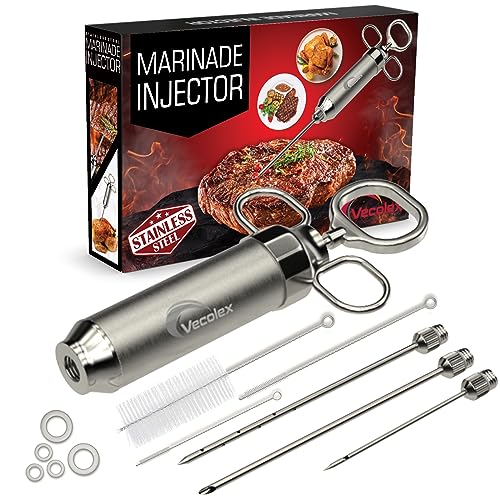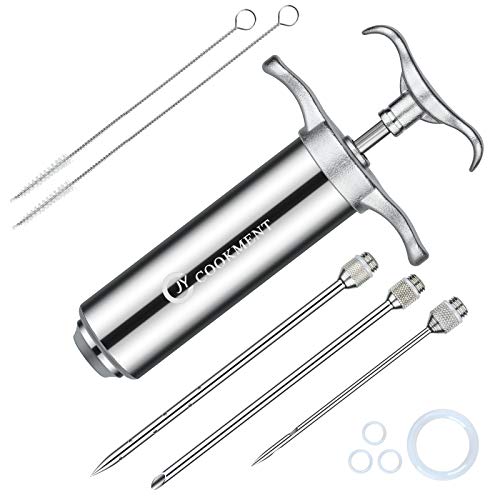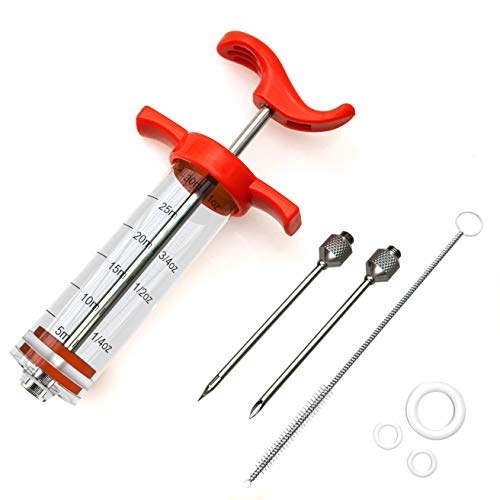
Ofargo Meat Injector Kit
| Pros | Cons |
|---|---|
|
|
Our content is meticulously curated through independent research, testing, reviews, and AI-driven recommendations, all designed to present you with the finest product choices. When you make a purchase through our links, it could result in us earning a commission.

Meat injectors, also known as flavor injectors or marinade injectors, are essential tools for enhancing the flavor and juiciness of your favorite cuts of meat. Whether you're grilling, smoking, or roasting, these devices allow you to infuse your meats with delicious marinades, brines, or seasonings, ensuring every bite is packed with flavor. In this guide, we'll explore the best meat injectors of 2024 along with important factors to consider when choosing a meat injector and helpful tips. The Ofargo Meat Injector Kit is worth a look. This all-inclusive kit has all the tools you need and is easy to assemble.
Choosing the right product can be a hassle, particularly if you're someone who doesn't know anything about cooking. Don't worry, in our buyer's guide, we’ll be covering the things you should know to find the perfect meat injector for your needs.
Even though most meat injectors on the marketplace are manufactured from food-grade stainless steel, it's important to pay attention to the overall quality of the product. If you're purchasing the meat injector from a physical store, then you can easily evaluate the material by brushing it with your hand. On the flip side, shopping online can be a bit harder. Here's a little trick that you can implement on your next purchase. First, open the review section. Then, just filter out all the reviews by pressing the "Stainless Steel" or "Material" tab. Lastly, go through all of the statements and see whether people are satisfied with the quality of the material or not.
Most meat injectors come with a standard capacity of 2 ounces. But, if you're planning to use this injector on bigger pieces of meat like beef steak or rib roast, then you should look for a more extensive model. This way, you will do less refilling and more cooking.
You should take the time to review the needles and consider whether they are suitable for your needs. For instance, if you're planning to inject simple sauces like juice, wine, or butter, then you can use a long needle that has multiple holes all over the surface. Conversely, if you want to inject salad dressings, hot sauces, or something you've made by yourself, then you should select a needle that has a large opening at the end.
If you're interested in purchasing a brand-new meat injector, then you should be fully prepared to spend anywhere from as little as $15 and even up to $120, depending on the model you're looking at. Find a meat injector that will perfectly suit both your necessities and your budget.
If you don't know how to use a meat injector, don't worry. We’ve prepared this step-by-step manual just for you — take a look.
Since you will be using the injector and needles for the first time, make sure that you carefully wash them with warm soapy water to get rid of any unwanted contaminants.
Spread a thin layer of food oil around the interior of the injector barrel before you start using it. This will provide better lubrication and will make the entire injection process a lot smoother.
Moving further, make sure that you decide what kind of sauce you plan on injecting into the meat. This can help you pick out the most suitable needle for the procedure.
Once you've decided which needle is most suitable for the process, all you need to do is screw it onto the injector and draw the sauce by pulling the handle. If it's a two-hole needle, make sure that both holes are submerged in the marinade before pulling the injector ring like a syringe.
Once your container is brimming with marinade, figure out the entry points in the meat. Try to keep them to a minimum.
Carefully place the needle inside the meat and steadily push the ring from the top. You can see the meat getting thicker as it absorbs all of the juices and marinade!
Lastly, wash your product by placing the needle in warm soapy water and repeating the previously-mentioned process to remove any unwanted particles from the item.

| Pros | Cons |
|---|---|
|
|

| Pros | Cons |
|---|---|
|
|

| Pros | Cons |
|---|---|
|
|

| Pros | Cons |
|---|---|
|
|

| Pros | Cons |
|---|---|
|
|